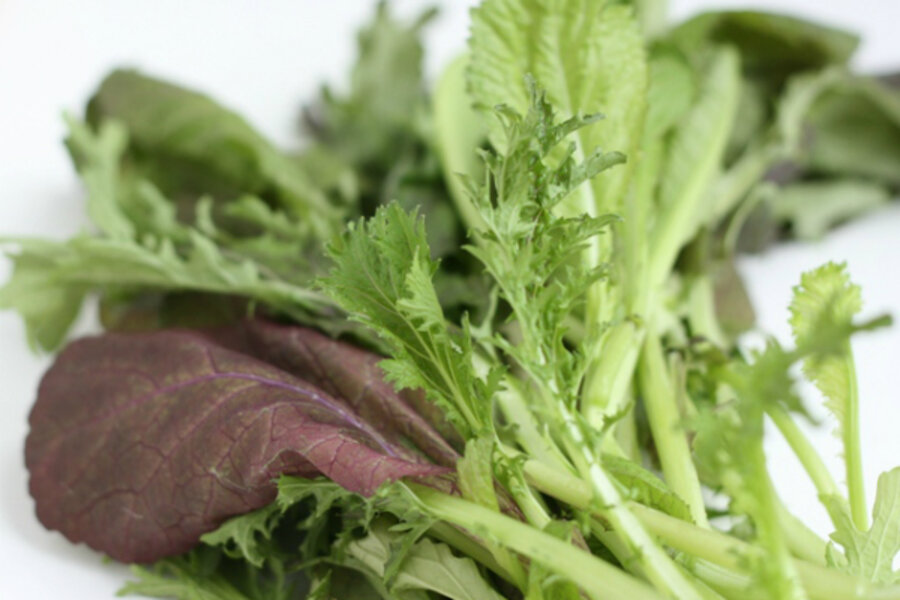Miso-mustard dressing
Loading...
This spring I found this beautiful specimen in my vegetable and fruit box, vaguely listed as “Asian lettuce mix.” Dirt still clinging to its roots, the bunch showed off a surprising array of appendages – frills, jagged edges, flat ovals, all in shades of green transfiguring into purple.
In my attempt to determine their attribution (mustard, mizuna?), I recalled my first encounter with vegetable incognito.
More than a decade ago, my husband and I were enjoying a two-year sojourn in the English countryside. It was springtime and I was lounging at a friend’s house. Muted late-morning sunshine massaged my shoulders as we sat in her garden among just-bloomed foxgloves and irises. A sparrow sunbathed open-winged on the freshly cut grass.
When it came time for lunch, my friend tasked me with picking some spinach for salad from her vegetable patch while she prepared the main course. As I stared at the neat rows of greens standing like soldiers in camouflage, my vision blurred – they all looked the same!
I grabbed blindly. And I came back with chard.
We had a good laugh about it. My friend pointed out the spinach (they looked like the supermarket variety’s darker, glossier cousin) and we still tossed the chard into our salad. But I realized I had no idea what vegetables looked like in the ground.
When we came back to the United States and bought our first house, I was determined to emulate my friend’s vegetable garden. I read up all I could on vegetable-planting best practices and lovingly planted cucumbers, tomatoes, kale, mizuna, bok choy and lettuce. Unfortunately, the amount of effort and money I put in didn’t quite measure up to the output. I concluded sadly that I didn’t inherit my dad’s green thumb. (OK, I admit it, I gave up.)
If nothing else, I came away from the experience hooked on freshly picked vegetables, preferably grown not far away.
So I latched on to the next best things: vegetable boxes (delivered!) and farmers’ markets.
Turns out that wasn’t the end of the sardonic episodes. There’s the head of celeriac that spent a week in my kitchen before I even realized what it was. It took another week for me to figure out what to do with it, and you can guess how it tasted by then. I also embarked on a love affair with parsnips, buying them at every farmers’ market sighting. One winter, I made carrot and parsnip stew on a weekly basis much to the chagrin of my meat-loving husband.
Ever the evangelizer, I espouse the wonders of seasonal eating to friends and family but it doesn’t always go as planned. Try explaining to an Asian grandmother set in her ways (i.e. my mom) that you throw away all the leaves of an artichoke and only eat the heart (she was horrified by how much was wasted), or that rainbow chard stir-fried with oyster sauce tastes just as good as bok choy.
Yet, like all old habits, this one dies hard.
Back to the Asian lettuce mix. Despite not getting to know each lettuce individually, I place full trust in my farmers. The lettuce probably came from a farm nearby or not too far away and were farmed using sustainable methods, both factors promoting a tastier, nutrient-packed product. It was possibly picked only 24 hours ago, and that’s pretty fresh as it goes. Then there’s the feel-good factor of seasonal eating: I feel connected to the rhythms of nature.
Yes, it takes effort. But I know every veggie eaten in season means one step toward eating the way our forefathers ate, the way Mother Nature meant it to be.
I’ve even introduced my mom to the joys of shopping at the farmers market – they have bok choy!
Miso-Mustard Dressing
I love making my own salad dressings and this recipe adapted from Jaden Hair’s "Steamy Kitchen Cookbook" is one of my favorites. IMHO, Asian lettuce mix + miso-mustard dressing is a match made in heaven.
Time: 5 minutes
Makes: 1 cup dressing
2 tablespoons white (shiro) miso
1 tablespoon sugar
1 teaspoon wholegrain mustard like Dijon
1 Asian/small shallot, minced (about 2 tablespoons)
1/2 cup vegetable oil like canola or sunflower
1/3 cup rice vinegar
Salt and pepper to taste
1. Combine all the ingredients in a glass jar with a screw-cap. Screw on the cap tightly and shake vigorously to mix. Toss dressing with greens, Asian or not, and serve.
2. Dressing will keep in the fridge for one week and is delicious drizzled over tofu, green beans and grilled eggplant.






